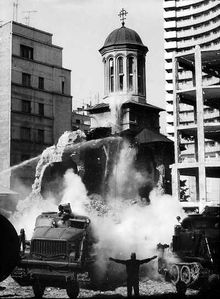Vrancea zone
The Vrancea Seismic Zone is the most earthquake -prone region in Romania . The region is located on the Romanian Carpathian Arch and includes parts of the Vrancea district and the neighboring districts of Buzău and Vaslui . The earthquakes occur in this zone at a depth of 60 to 200 km.
Emergence
After the former continuous subduction along the Alpine-Carpathian arc in the Eocene was stopped by a continent-continent collision in the Alps, it only continued in the indentation of the European continental margin between the Western European and Moesian platforms. During the Middle Miocene , the subduction zone shifted further and further into the indentation. As a result, the North Pannonian and Tisia - Dacia blocs filled these more and more. This process continued until a continent-continent collision occurred first at the northern edge of the indentation and then gradually also at the south-eastern and southern edge areas, which ended the subduction process. This is interpreted as the last stage in the detachment of a descending lithospheric plate. Since the vertical extension of the descending lithospheric plate under the Vrancea region, as evidenced by the seismicity, indicates a gravitational sinking of the plate with simultaneous mechanical coupling to the overlying crust, the detachment in this area cannot yet have taken place completely. Since medium-depth earthquakes are only observed under the Vrancea region, it can be assumed that the submerged plate segments have already completely detached under the other regions.
description
Vrancea quakes are of interest not only because of the seismic hazard they pose , but also because of the extraordinary, rarely observed, tectonic process on which they are based. With regard to the orientation of the focal areas , two types of earthquake are to be distinguished, those with a north-east-south-west swept area and compression perpendicular to the mountain arch and those with a north-west-south-east swept area and compression parallel to the mountain arch, whereby the former type generally occurs more frequently. The importance of the Vrancea region as a source of seismic hazard is also underscored by the fact that its momentum release rate is similar to that of all of southern California . Due to the medium-depth Vrancea earthquakes, Romania and its neighbors Moldova and Bulgaria are exposed to a high seismic risk. As the most important urban agglomeration in the vicinity, Bucharest bears most of it.
The two earthquakes on March 4, 1977 and August 30, 1986 had catastrophic effects on Romanian territory. According to official figures, 1,570 people died during the quake on March 4, 1977, 11,300 were injured and 32,500 residential and 763 industrial buildings were destroyed or severely damaged. Educational, medical and commercial networks, as well as cultural institutions and historical structures, government buildings and various buildings and facilities from the agricultural sector were badly affected. According to an estimate by the World Bank, the total direct damage was 2 billion US dollars .
exploration
The region was researched in 1996 by the "Strong Earthquake" Collaborative Research Center of the German Research Foundation at the University of Karlsruhe . In cooperation with various Romanian partner institutions, strategies for risk reduction and disaster management were developed and implemented. The main goal of the research group was the creation of real-time vibration maps . Furthermore, the group presented the modeling of the Vrancea earthquakes of March 4, 1977 and August 30, 1986 with the help of the Irikura simulation method. The determined focus parameters serve as a possible basis for future soil movement simulations . This in turn represents a central element of the risk analysis.
Earthquake in the Vrancea Seismic Zone
The list includes the strongest earthquakes in the Vrancea region.
| date | depth | epicenter | Strength | dead | Injured |
|---|---|---|---|---|---|
| August 29, 1471 | 110 km | 7.1 | |||
| November 24, 1516 | 150 km | 7.5 | |||
| April 30, 1590 | 100 km | 7.3 | |||
| August 9, 1679 | 110 km | 7.5 | |||
| June 11, 1738 | 130 km | 7.7 | |||
| April 5, 1740 | 150 km | 7.3 | |||
| April 6, 1790 | 150 km | 7.1 | |||
| October 26, 1802 | 150 km | 8.2 | 4th | ||
| November 26, 1829 | 150 km | 7.3 | |||
| January 23, 1838 | 150 km | 7.5 | 73 | 14th | |
| 17th August 1893 | 100 km | 7.1 | |||
| August 31, 1894 | 130 km | 7.1 | |||
| October 6, 1908 | 125 km | 7.1 | |||
| November 10, 1940 | 133 km | 7.7 | 1000 | 4000 | |
| September 7, 1945 | 80 km | 6.8 | |||
| March 4th 1977 | 94 km | 7.2 | 1700 | 11,386 | |
| August 30, 1986 | 131 km | 6.9 | 2 (official) | 558 | |
| May 30, 1990 | 89 km | 6.7 | 14th | 362 | |
| October 27, 2004 | 98.6 km | 6.0 | - | - |
Individual evidence
- ↑ a b c d Wolfgang Wirth: Seismic ground movement in Bucharest (Romania) - investigation of lateral variations and modeling with empirical Green functions , University of Karlsruhe : Dissertation

